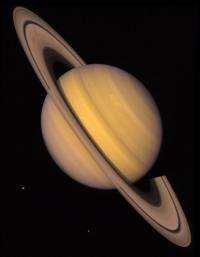STAR TRAK for April

Saturn will gleam at its biggest and brightest for the year during April, remaining near its peak of visibility for most of the night throughout the month.
The bright yellow planet will be opposite the sun in our sky on April 15 ("at opposition"), when it will rise at sunset and be visible all night. The best views through a telescope will be when it is highest in the southern sky in the middle of the night. Saturn will outshine nearby Spica, the brightest star in the constellation Virgo the Maiden. Visit saturn.jpl.nasa.gov/home for the latest news and images from the Cassini spacecraft orbiting Saturn.
Saturn's biggest moon, Titan, will be due south of the planet on April 18 and due north on April 10 and 26.
Venus will dominate the western evening sky in April, remaining high above the horizon long after nightfall and setting four hours after the sun. The brilliant planet will glide past the Pleiades star cluster during the first few days of the month. To the unaided eye, the glare of Venus will seem to overwhelm the Pleiades, but binoculars will give a beautiful view of both the planet and the star cluster.
Jupiter will be low in the west after sunset in early April, almost directly below Venus and much less bright. A telescope won't reveal much detail because of the planet's low altitude. Each night Jupiter will appear lower, and by month's end it will disappear into evening twilight.
Mars will come into view at dusk early in the month, halfway up the southeastern sky in the constellation Leo the Lion. By late April, it will begin the evening high in the south. The orange-red planet will easily outshine Leo's brightest star, blue-white Regulus. Now just a month past opposition, Mars will be a fine object for viewing with a telescope, especially early in the month when it will appear larger.
Mercury will have its poorest morning appearance of 2012 during April, rising less than an hour before the sun all month for observers at mid-northern latitudes. It will be just 4 degrees above the eastern horizon a half hour before sunrise, difficult to see in bright twilight even with binoculars.
Light pollution
A great deal of energy and money is wasted on inefficient, improperly directed outdoor lighting. To help call attention to this problem of light pollution, the International Dark-Sky Association encourages people in the United States to turn off unnecessary outside lighting during National Dark-Sky Week, which will be from April 14 to 20 this year. More information is available at the association's website.
Meteor shower
The Lyrid meteor shower will peak on the night of April 21-22 in a moonless sky, offering ideal viewing conditions. For observers in North America, about 20 meteors per hour should be visible in a clear, dark sky.
The meteors can appear anywhere in the sky, but they will seem to come from a point called the radiant in the constellation Lyra the Harp, which gives the shower its name. Lyra's bright white star Vega will be almost at the radiant, and the meteor count should be highest when Vega is well above the eastern horizon between late evening and dawn.
Moon phases
The moon will be full on April 6, at third quarter on April 13, new on April 21 and at first quarter on April 29.
Provided by Indiana University




















